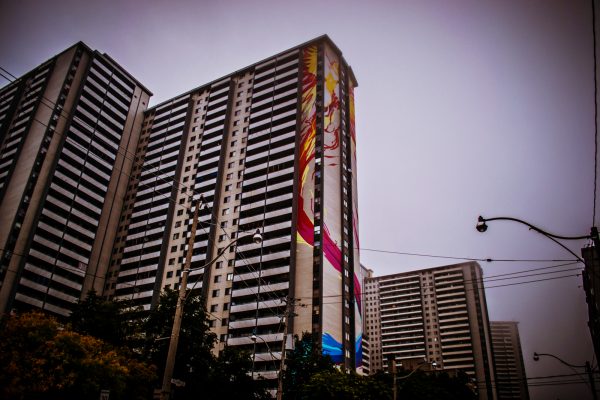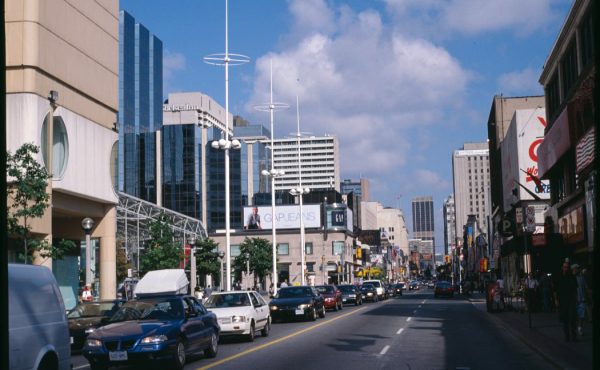Covid-19 is making everyday life feel like dystopian fiction. But imagine an even more apocalyptic scenario: what if Canada’s health system looked like our housing system?
In this terrifying alternate universe, our health system would be 96% privatized, and emergency rooms would be the only publicly-funded health care service available to all. If you didn’t have the income to pay for a family doctor or a hospital stay, you would have to crowd into an under-equipped and understaffed ER anytime you needed health care, whether for a catastrophic accident or the flu. The ER would be so scary and degrading and pestilential, you would do anything to avoid going there. But without affordable health care to meet the demand, 235,000 people would find themselves there every year, 35,000 on any given night. If a pandemic hit, we would be doomed.
In Canada, universal health care means that Covid-19 testing and treatment are available to everyone who needs it. It also means that the population as a whole is less vulnerable to the worst impacts of the virus because of a good average state of health, thanks to life-long preventative and primary care. This public health emergency decisively demonstrates the value of our public investment in health care.
But now, faced with the possibility of an epidemic that could overwhelm our health system, our ability to contain transmission of the virus is severely compromised by decades of under-investment in our housing system.
It wasn’t always this way. Back in the 1980s, Canada had a robust social housing system that produced 20,000 homes each year with rents geared to their occupants’ incomes. But since the early 1990s, successive federal and provincial governments have slashed public funding for housing. Today only four percent of all housing is non-profit, with decade-long waiting lists. The vast majority of households, regardless of income, must pay for housing in the private market, or end up in a shelter – the emergency room of the housing system. And now that the pandemic has hit, we’re seeing the consequences.
It’s not just about homelessness: 1.5 million renters have housing that is unaffordable, overcrowded, or unsafe. They can’t afford to take time off work, whether for self-isolation, to look after kids while whose schools are closed, or because they are sick or caring for sick family members. The low-waged workers most affected by loss of income due to containment measures—who are disproportionately female, young, and racialized—are going to be in trouble when the rent comes due April 1.
Housing, like health, is a human right enshrined in a number of international treaties that Canada has signed. While Canada has long implemented the right to health, our domestic commitment to the right to housing is more recent. Just last June, the National Housing Strategy Act affirmed the right to adequate housing in Canadian law for the first time; in December, the City of Toronto followed suit with a 10-year housing and homelessness strategy based in human rights. By these commitments, governments pledge to “progressively realize” the right to adequate housing through their policies, and to provide immediate relief to those in urgent need.
International human rights experts have called for a human rights-based response to the global pandemic. Leilani Farha, Canadian housing rights advocate and UN Special Rapporteur on the Right to Adequate Housing, calls housing “the front-line defense against the Covid-19 outbreak.” A Toronto housing rights group has released a call to action for a pandemic response based on human rights.
A rights-based plan for Covid-19 has to work on two levels. The first is an immediate emergency response to contain the spread of the virus, protect those most at risk, and keep people housed. The second is a long-term plan to transform our housing system so it looks more like our health system.
Step one of the emergency response: increase the capacity of the shelter system. People who are homeless are at high risk of contracting Covid-19 in overcrowded shelters and drop-ins, and many are vulnerable to the worst effects of the virus because of their age and pre-existing health conditions. Women and children facing violence in their homes are at increased risk during this period of containment. Shelter workers are on the very front lines of the pandemic, yet they lack the training and personal protective equipment available to health workers. Some cities are experimenting with a visionary solution: re-purposing now-empty hotels to provide those in need of shelter with a safe, private, and dignified space to call home. Alberta cancelled Calgary’s hotel plan because of the cost – even though modelling by health system experts shows that this costs less than it would to treat everyone for Covid-19 if we allow the virus to spread like wildfire through the shelter system.
We also need to make sure nobody is pushed into homelessness during the crisis, which means protecting tenants from eviction. Though homeowners are protected by a six-month mortgage deferral, support for renters has been more piecemeal. Emergency income benefits that max out at $2000 per month won’t go far for tenants in Canada’s expensive cities: in Toronto, for example, 30% of tenants pay more than $1,500 in rent. A new report shows that one in four tenants don’t have the savings to get through even one week without pay. Ontario, Québec, B.C., Saskatchewan, Alberta, and Nova Scotia have declared a moratorium on evictions for now – but what about down the road when benefits end and arrears have piled up? Tenants across the country are calling on provincial, territorial, and federal governments to provide relief to renters and ban Covid-related evictions. In the absence of government action, tenants are also self-organizing to hold back April rent and communicate proactively with landlords.
But even as officials work day and night to get emergency measures in place, they can’t lose sight of the future. That old neoliberal adage, “Never let a serious crisis go to waste,” is getting a lot of play these days. During the 2008 global financial crisis, international investment firms reaped the rewards, swooping in to acquire “distressed assets” and prompting an upward spiral in the value of global real estate that exacerbated housing insecurity the world over. Recent comments from the co-founder of Blackstone show that they are poised to do this again.
Imagine if instead, this time around, we seize this moment to transform our housing system in the image of our health system. If, in the words of a UN expert, governments use stimulus measures to secure “the full enjoyment of human rights by all.” If new protections for renters prompt a reassessment of the human cost of evictions. If new emergency benefits become the scaffolding for a better income security system. If cities and non-profits acquire shuttered hotels and take apartment buildings off the books of bankrupt corporations, to instantly expand our stock of social housing. If home is finally treated not as a commodity, but as a fundamental human right.
If we heed the lessons of the Covid-19 pandemic, we can build a resilient housing system that provides adequate and affordable housing for all, and protects us when the next crisis strikes.
photo by Ashton Emmanuel
Emily Paradis researches homelessness and housing, and teaches Urban Studies at University of Toronto. A Maytree fellow, she is a steering committee member of Right to Housing in Toronto and the National Right to Housing Network. Follow her on twitter at @EmilyKParadis.





One comment
People often ask, “What does a right to housing even look like?” Now we know, let’s prepare to act.
The Bloomberg article cited in this posting, “Blackstone sees buyout opportunities with virus-cheapened assets,” shows what can happen if we, the public and our elected representatives, don’t step up.